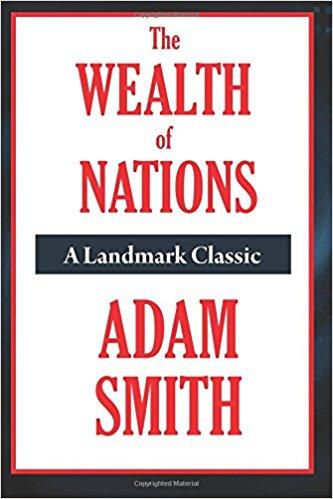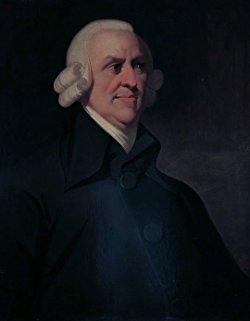The Wealth of Nations Summary

5 min read ⌚
 How did the global economy become what it is today?
How did the global economy become what it is today?
What has the division of labor done for humankind’s transformation?
This time, we are summarizing the main ideas of legendary theorist and thinker Adam Smith.
Who Should Read “The Wealth of Nations”? And Why?
Every serious economist knows deeply about Adam Smith and his “An Inquiry into the Nature and Causes of the Wealth of Nations.”
Adam Smyth’s theories and ideas have inspired some of the most famous economists over the last few centuries, including Vilfredo Pareto, David Ricardo, and Milton Friedman.
“The Wealth of Nations” is a classic which offers a look at the history of economics. We recommend this book to all economists and economics enthusiasts.
About Adam Smith
 Adam Smith was the son of a jurist, born in 1723. He studied in Oxford and Glasgow, and taught for some time, after which he began teaching logic at Glasgow University in 1751, and moral philosophy one year later.
Adam Smith was the son of a jurist, born in 1723. He studied in Oxford and Glasgow, and taught for some time, after which he began teaching logic at Glasgow University in 1751, and moral philosophy one year later.
During this endeavor, he was in contact with David Hume, whose economic ideas left their mark on him.
In 1763, Smith left on a two-year educational journey through Switzerland and France. He met with Turgot and Quesnay, who influenced Smith substantially.
He soon developed the concept for his opus magnum, “The Wealth of Nations”.
However, he finished the work more than a decade later and published it in 1776.
He died in Edinburgh, on July 17, 1790. Before he passed away, he asked his friends to destroy all of his unfinished work.
“The Wealth of Nations Summary”
The division of labor has transformed the markets and improved productivity.
Division of labor means that instead of one worker producing the whole product, from scratch to its final form, production is now divided into individual steps.
It is safe to say that the division of labor is one of the most significant transformations of progressive society.
But how did it develop?
Well, not all people have everything, and not all people know to do everything.
So, people needed to exchange goods and find a proper way to practice their talents and specialize in the fields they want.
Now, while we are on the topic of exchanging goods, let’s talk about trade.
For trade to function, consumers and suppliers need to have a meeting place – a market. The size of the market has a crucial influence on the division of labor.
Specialization functions in big markets only.
A long time ago, people traded by exchanging goods. However, such an exchange was impractical, so people invented money.
However, you have to keep in mind that money is not what gives a commodity value. The real value of a commodity comes from the costs acquired while producing it. In other words, the value of a product is equal to the labor needed to create it.
If we calculate value this way, we will understand that the real price of commodities is stable and does not fluctuate, since it always involves the same amount of labor.
But, wait, then why do prices fluctuate all the time?
The prices that you see changing are the nominal prices, which are affected by different things.
Depending on the level of development of a particular society, the commodities develop natural prices, which are similar to their labor costs.
Now, there are instances when the selling price can be the same as the purchase price. Such is the case when a seller cannot make a profit, so he must sell the goods at the amount he paid for them.
The market price is another term you need to know, which is the price that a seller can achieve.
The market price is connected to the supply and demand forces in the market. When the supply is higher than the demand, prices fall. Conversely, if a commodity is rare, and the demand is booming, prices will skyrocket.
A commodity will sell for its natural price in cases when there is a balance between supply and demand.
This explains why, when a supplier manages to create a monopoly, he can keep the supply low, and prices high.
Before the division of labor happened, no one needed stockpiled supplies.
When people felt a lack of something, like for example of food or clothing, they could act on it at the moment. They used raw materials to satisfy their daily needs.
However, when people started producing commodities and the division of labor was established, people had to start storing goods.
People who succeed in generating a surplus of goods started selling them, and those goods became their revenue-generating capital.
There are a few types of capital.
Goods that are produced and sold immediately are “circulating capital.”
Tools, property and machines are “fixed capital” or “capital assets.”
Usually, the definitions that apply to individual capital are also accurate and can be used to define national capital.
For example, the capital assets of a country are its properties, businesses, machinery, as well as the skills and talents of its citizens.
The circulating capital, on the other hand, consists of the storage of supplies and goods, both finished and semi-finished, as well as the money in circulation.
Key Lessons from “The Wealth of Nations”
1. The Flaws of the Mercantile System
2. The Ways States Fostered Exports in the Mercantile System
3. The Tasks of the State
The Flaws of the Mercantile System
The mercantile system neglects the consumers and serves only traders. It is highly dangerous and deceptive. It had two main flaws:
-
- The nation’s wealth equals the amounts of silver and gold in its possession.
- Maintaining a favorable balance of trade: more substantial exports and imports.
The Ways States Fostered Exports in the Mercantile System
-
- They granted reimbursements to exporters whose goods initially were subject to government duties.
-
- They provided subsidies for some trades.
-
- Individual state trade agreements granted privileges for home country goods.
- States founded colonies where their merchants could have monopolies.
This entire mercantile system is a deceptive, highly dangerous construct. It serves only producers and
The Tasks of the State
-
-
- National defense
- Justice
-
- Public institutions
Like this summary? We’d Like to invite you to download our free 12 min app, for more amazing summaries and audiobooks.
“The Wealth of Nations” Quotes
All the different nations of Europe have studied, though to little purpose, every possible means of accumulating gold and silver in their respective countries. Share on X Labor was the first price, the original purchase money that was paid for all things. Share on X The substitution of paper in the room of gold and silver money replaces a very expensive instrument of commerce with one much less costly. Share on X The wealth of a neighboring nation, however, though dangerous in war and politics, is certainly advantageous in trade. Share on X The subjects of every state ought to contribute towards the support of the government, as nearly as possible, in proportion to their respective abilities. Share on XOur Critical Review
No one has ever read an economics textbook that did not encounter Adam Smith’s name.
However, more often than not, his theories are used in fragments and are taken away from context.
Hence, when you read “The Wealth of Nations” have in mind the context that surrounded Smith during the development of his theory. Read something more about the monopolization of the world’s precious metal reserves, and the recreation of the export policies.
Then you will be able to comprehend Smith’s work completely.








